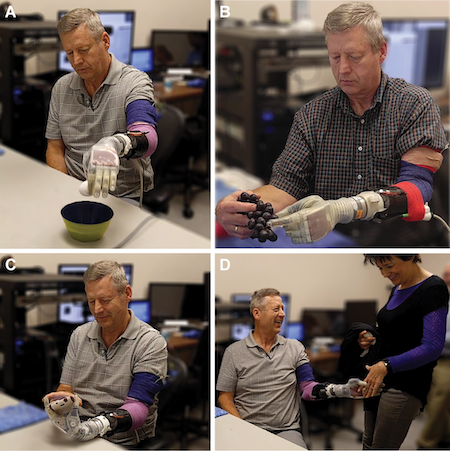
Since 2019, the University of Utah has been developing the world’s most advanced “neuroprosthesis” — an artificial upper arm and hand that is controlled by the user’s thoughts. Named the “LUKE Arm” after the prosthesis the Star Wars protagonist is fitted with at the end of The Empire Strikes Back, the device has garnered international acclaim (including kudos from Luke Skywalker himself, Mark Hamill).
The LUKE Arm, developed by the company DEKA, is a multiarticulate bionic arm capable of recreating many of the movements of the human hand. Inside it, the technology that allows the LUKE Arm to be controlled by thoughts is a direct nerve interface developed at the University of Utah. This technology is not yet commercially available, but promises a range of future neuroprostheses that directly connect with the user’s nervous system.
Now, the project is reaching a new milestone — the technology behind the LUKE Arm is ready to be tested outside the lab.
A new contract with startup Biologic Input Output Systems (BIOS) will support the University of Utah’s ongoing Investigational Device Exception Early Feasibility Study, allowing for the recruitment of the clinical trial’s next participant.
“Most importantly,” says Utah NeuroRobotics Lab Director Jacob George, “this patient will be the first to take the LUKE Arm home and use it independently for their daily activities.”
George, an assistant professor in the Price College of Engineering’s Department of Electrical & Computer Engineering and the Spencer Fox Eccles School of Medicine’s Department of Physical Medicine and Rehabilitation, also serves as Chief Scientist for BIOS. In 2022, BIOS executed a licensing agreement with the University of Utah for the technology behind the neuroprosthesis, and continues to evolve the technology towards commercialization.
The University of Utah’s clinical trial has thus far enrolled eight participants, under the supervision of emeritus biomedical engineering professor, Gregory Clark, and orthopedic professor and surgeon, Douglas Hutchinson. Under Clark and Hutchinson, and with support from the Defense Advanced Research Projects Agency and the National Science Foundation, the patients helped test the bionic arm’s increasing array of capabilities, including the ability to provide the user with a sense of touch. Each of these patients used the device under supervision of engineers and clinicians on the University of Utah’s campus. Now, with George’s and BIOS’s added involvement, the next patient will take the technology out of the lab and help transition advanced neuroprostheses, such as the LUKE Arm, into a commercial product.
The overwhelmingly positive results of this technology to date earned the BIOS direct nerve interface a “Breakthrough Device Designation” from the FDA in March 2024, as well as admission into its Total Product Lifecycle Advisory Program. The FDA uses these programs to fast-track promising experimental medical devices toward everyday use.
The latest iteration of the technology’s software and AI allows for more life-like sensation, increased dexterity and more intuitive control, making that kind of unsupervised, everyday use feasible for the first time. The BIOS direct nerve interface can also be integrated with other technology, like other robots, virtual reality systems, or phones/computers, so that individuals can seamlessly control and feel from their devices with just their thoughts.
“We’ll now get to see how much more impactful this technology is when used daily for real-world activities,” George says. “We’re replacing the lost function of the hand, and with extended use, we hope this technology can also restore the full range of physical and emotional experiences enabled by our hands.”
The ongoing clinical trial is for transradial amputees. To enable the thought-based control of a robotic arm, enrolled patients will have Utah Slanted Electrode Arrays (USEAs) and intramuscular electromyographic recording leads (iEMGs) implanted into their residual arm nerves and muscles. After being fitted with the device in the lab and undergoing preliminary tests, the participants will then have the opportunity to take the device home for a period of one year, and potentially longer.
This next phase of the project marks an exciting step towards the commercialization and real-world implementation of an advanced neuroprosthesis. This project stems from the pioneering work of emeritus faculty member Richard Normann, who invented the Utah Array, as well as faculty member Florian Solzbacher, who commercialized the technology through Blackrock Neurotech. Blackrock Neurotech is another University of Utah-associated startup company that recently received a $200 million investment to expand their brain-computer interface technology.
For more information on the Luke Arm research, contact Dr. Jacob A. George (jacob.george@utah.edu).